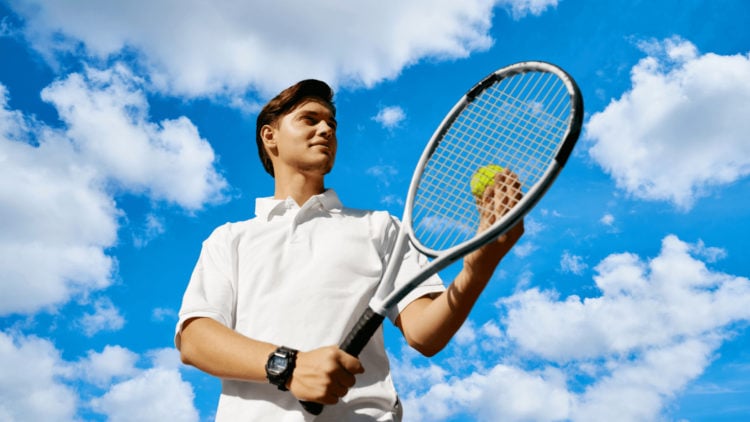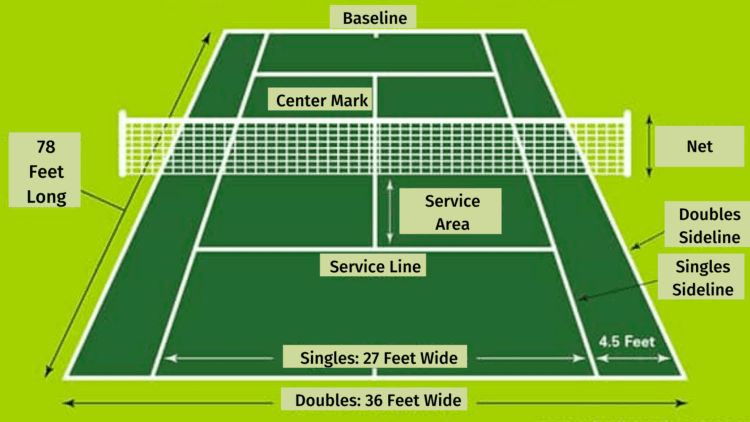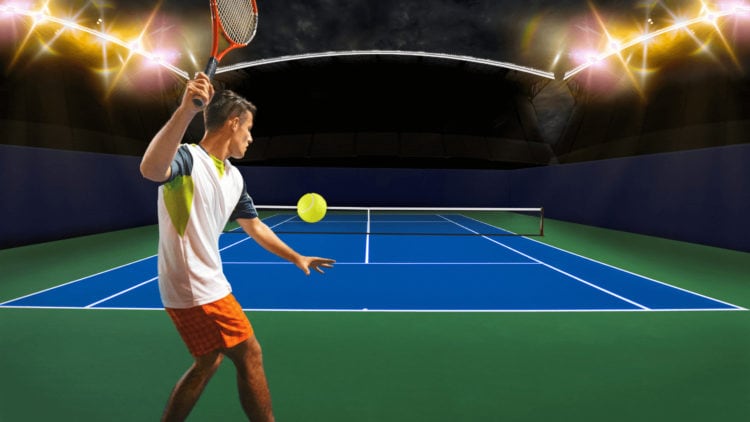
OBJECTIVE OF TENNIS: Get points by hitting the ball to the opponent’s side of the court so that the opponent is unable to return the ball.
NUMBER OF PLAYERS: 2 or 4 players, 1 or 2 on each team
MATERIALS: 1 tennis racket per player, 1 tennis ball
TYPE OF GAME: Sport
AUDIENCE: 5+
OVERVIEW OF TENNIS

Tennis is a racket sport where two teams hit a ball back and forth across a court. It can be played as singles or doubles. Tennis is one of the most popular individual sports in the world and is followed by legions of fans due to famous names like Serena Williams and Rafael Nadal.
SETUP

A tennis court is a rectangular court with a low net that stretches in the center across the width to divide the court into two. Almost all tennis courts will be set up for both singles and doubles matches. The tennis court should be 78 feet long, and the width is 27 feet for singles matches and 36 feet for doubles matches.
The service lines are centered horizontally on the two sides of the court and the baseline should run horizontally along the width of the tennis court at the very ends. The lines that run down vertically are called sidelines. There will normally be two sidelines to mark the limits for singles and doubles matches. And finally, the center mark is a line that goes down the center of the court.
Tennis can be played on a variety of different flooring surfaces. The four main types are grass courts, clay courts, hard courts, and carpet courts. Tennis can also be played indoors.
GAMEPLAY

A tennis match always starts with a coin toss. The winner of the coin toss has the option to:
- Serve first
- Receive first
- Choose which side to start on
If the winner of the coin toss decides to serve, the losing player can decide which side of the court they want to start the match. A tennis match consists of points, games, and sets.
Serving
The server stands between the sideline and the center line and behind the baseline. Players are required to serve diagonally, so the server can choose whether to serve diagonally on the right or left side of the tennis court.
Once in position, the server serves a ball. In order for it to be considered a “legal serve”, the server must:
- Throw the ball in the air
- Hit the ball with the racket
- Hit the ball before it hits the ground
- Hit the ball diagonally across the court
- Hit the ball so that it lands within the serving line of the receiver’s side of the court
Alternate Serves
The tennis players alternate serves with each game. So, one player will serve the entire duration of a single game until the game is finished. Once the first game is done, the second player will serve the second game, and so on.
The server must also alternate between the two vertical halves of the court after each point is awarded.
Fault
There are two types of faults in tennis: service faults and foot faults.
- A service fault happens when the ball’s first bounce occurs outside of the serving area.
- A foot fault happens when a player steps on or outside of the baseline or the sideline while serving.
After two faults in a row, the receiving player is automatically awarded a point.
Let
During a serve, if the ball hits the net but is otherwise still a legal serve, the server gets another two chances to serve. In other words, if a “let” is called, the server still gets two tries to hit a valid serve.
In Doubles
Just like in singles, doubles tennis only has one server for the entire game. Then the opposing doubles team’s first server will get to serve in the second game. In the third game, the second server in the first team player will get a chance to serve. And the fourth game is served by the opposing team’s second server.
Rallying
Once a ball is successfully served, the ball will be in play, also called a rally. The two teams will alternate hitting the ball across the court until a point is scored.
In order to properly return a serve, the receiving player must hit the ball before the ball bounces twice on their side of the court. The rally continues until a point is scored.
Volleys
In tennis, you can volley the ball, which is where you hit the ball before it touches your end of the court.
In Doubles
When receiving a serve, the doubles partners must stand on opposite sides of the court. The doubles rules state that the players must stay on the same side for the duration of a set.
Scoring
Tennis is played in points. The point sequence is as follows:
0 point = love
1 point = 15
2 points = 30
3 points = 40
4 points = game
In order to win a game, a player must win by at least two points. So, if the two teams are at 40-40, a “deuce” is called. The winner of the next point is awarded an “advantage” at which point the winner can win the game by taking the second point. However, if the next point brings the score back to a deuce, the game will continue until a player eventually wins the game by two points.
Here are the ways to gain points in tennis:
- The opponent is unable to hit back a valid shot.
- The ball bounces twice on the opponent’s side of the court.
- The opponent hits the net with the ball.
- The opponent hits a shot outside of court boundaries.
- The opponent serves a double fault.
END OF GAME
A tennis match is made up of points, games, and sets: 4 points with at least a 2-game advantage to win a game, 6 games with a margin of at least two games to win a set, and 2 or 3 sets to win a match. Most tennis matches will be played as a best of 3 or 5 sets.
- Comprehensive Guide to the Board Game Go (weiqi, baduk) - January 23, 2024
- Are Creative Suites Changing Gaming - October 30, 2023
- How Classic Games Have Been Reimagined for Modern Audiences - October 5, 2023